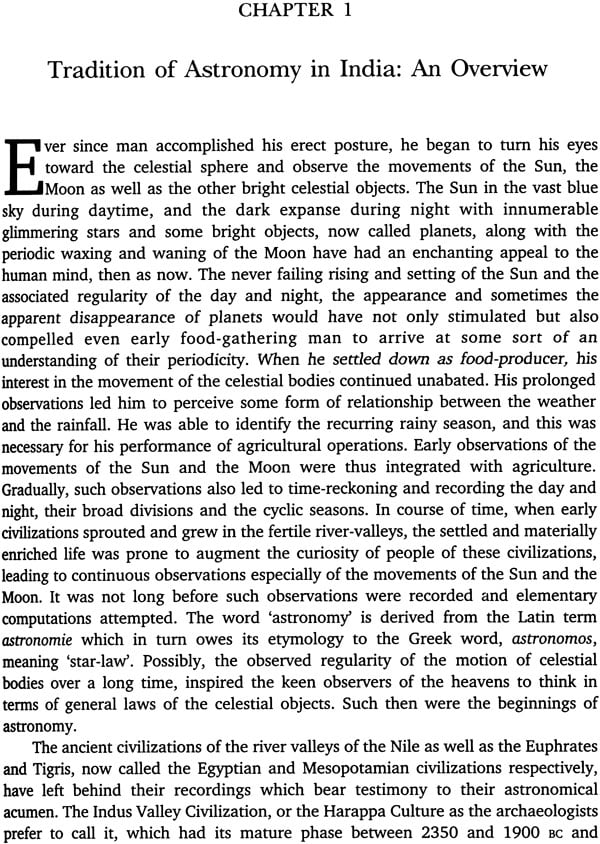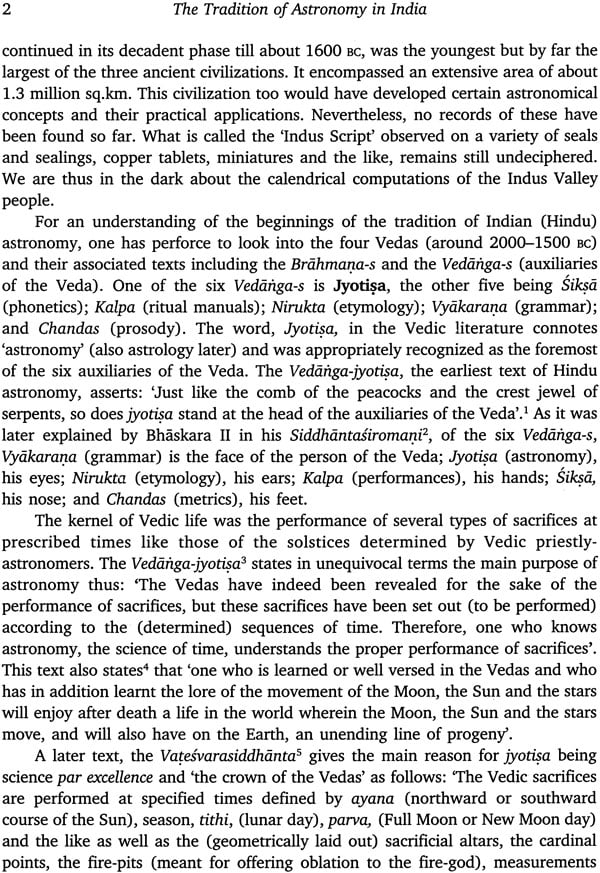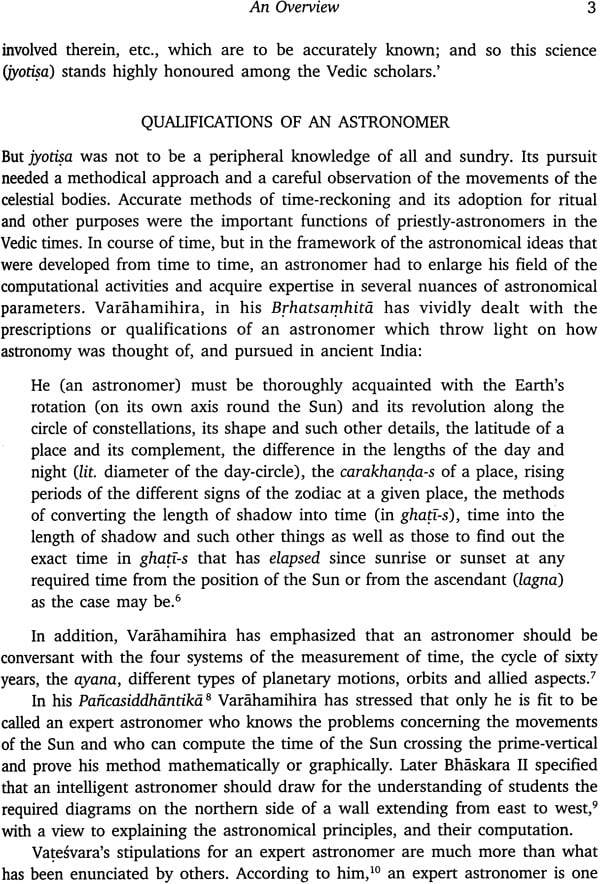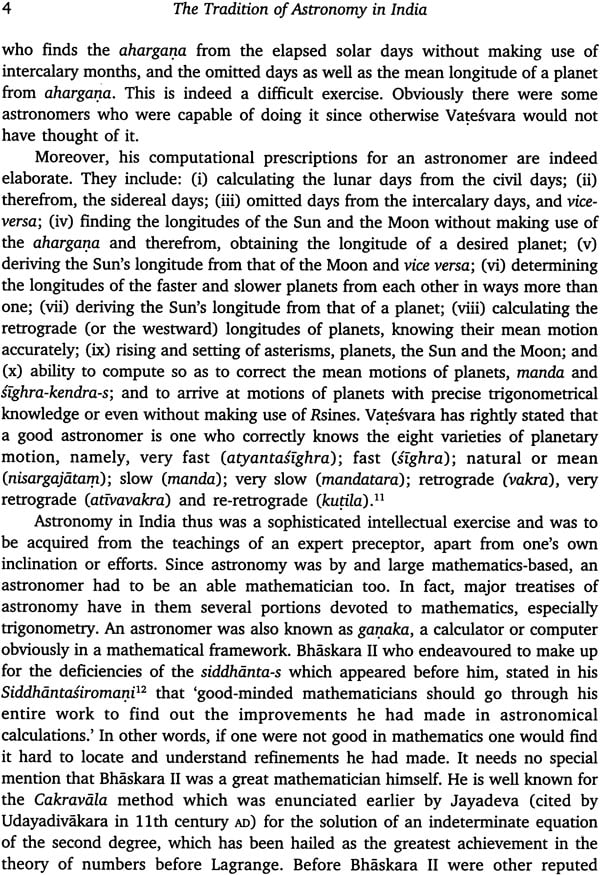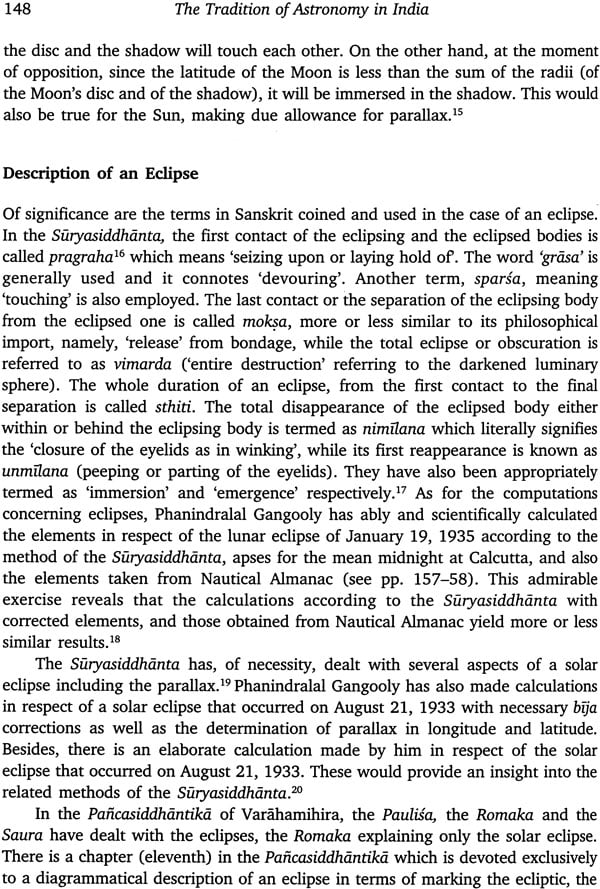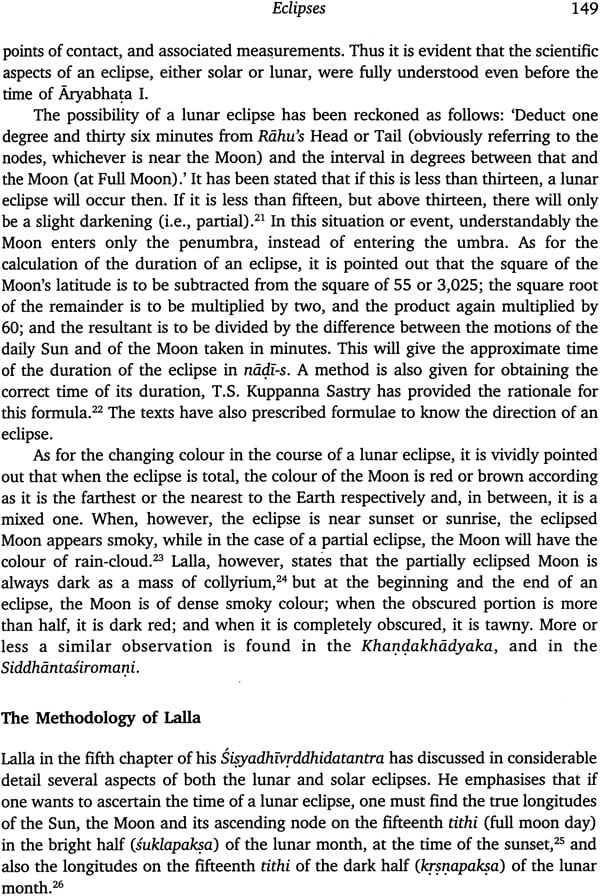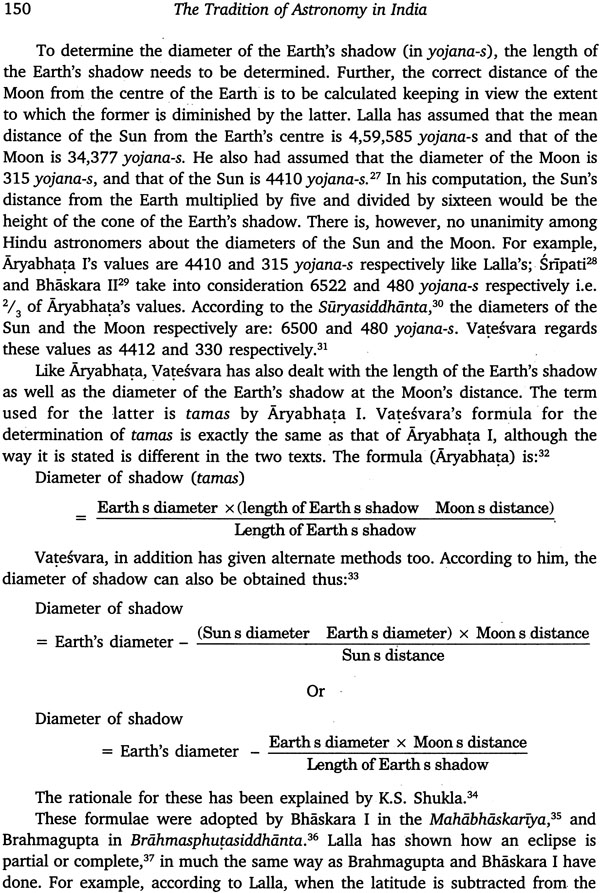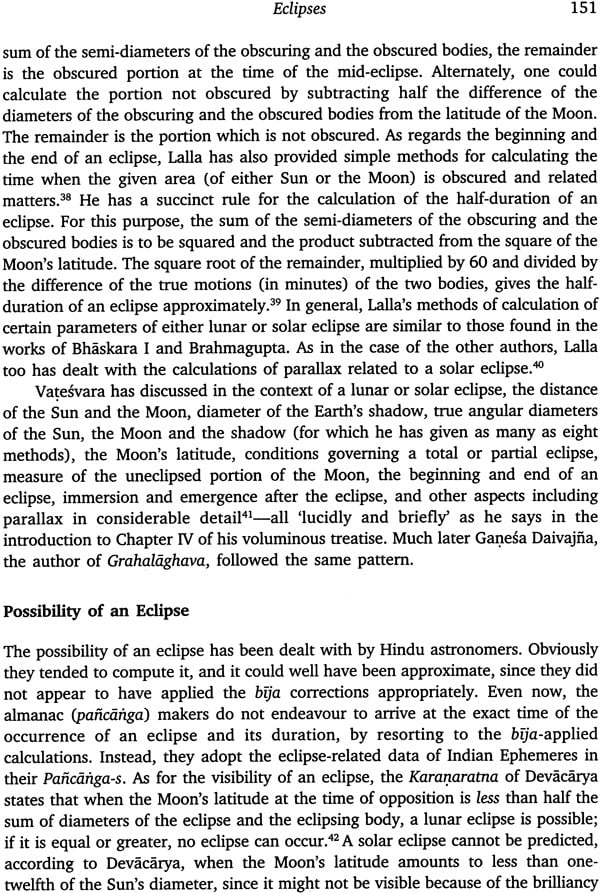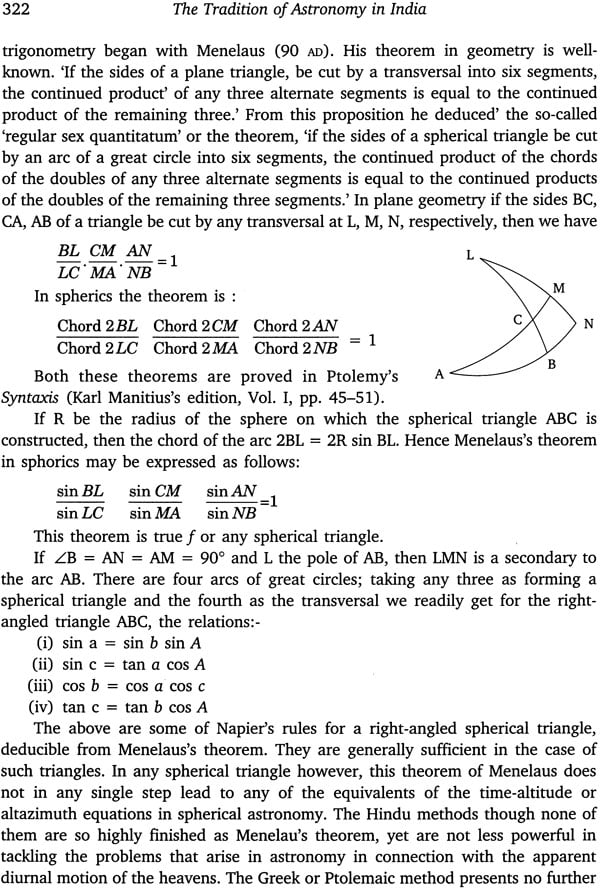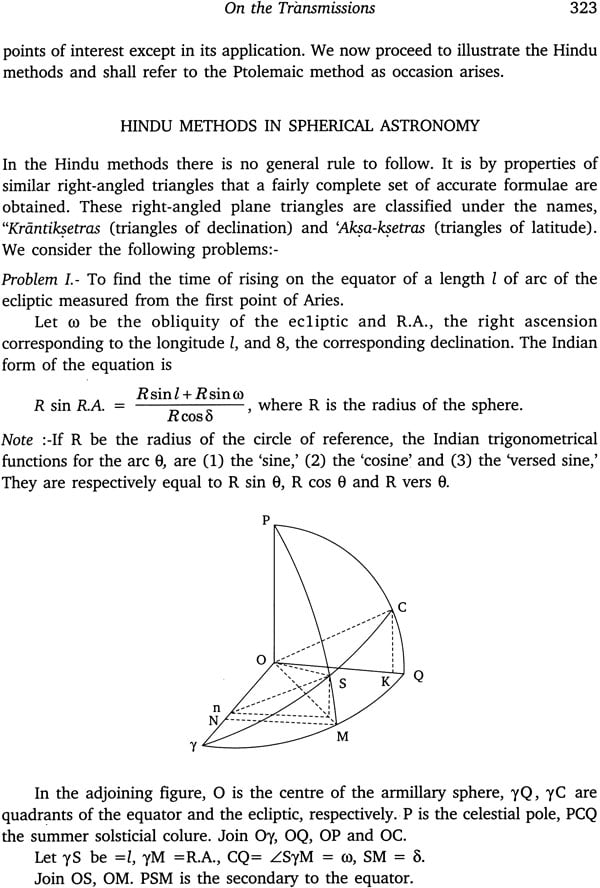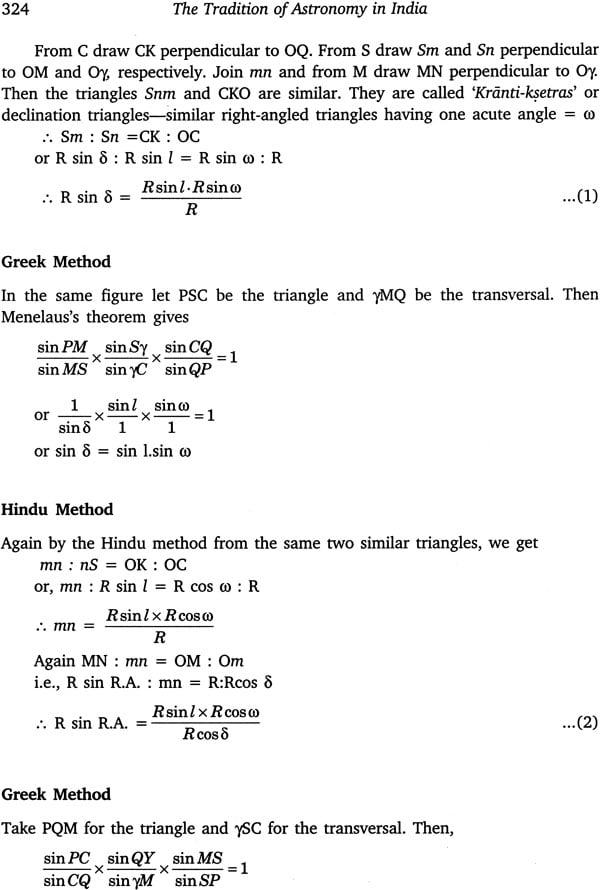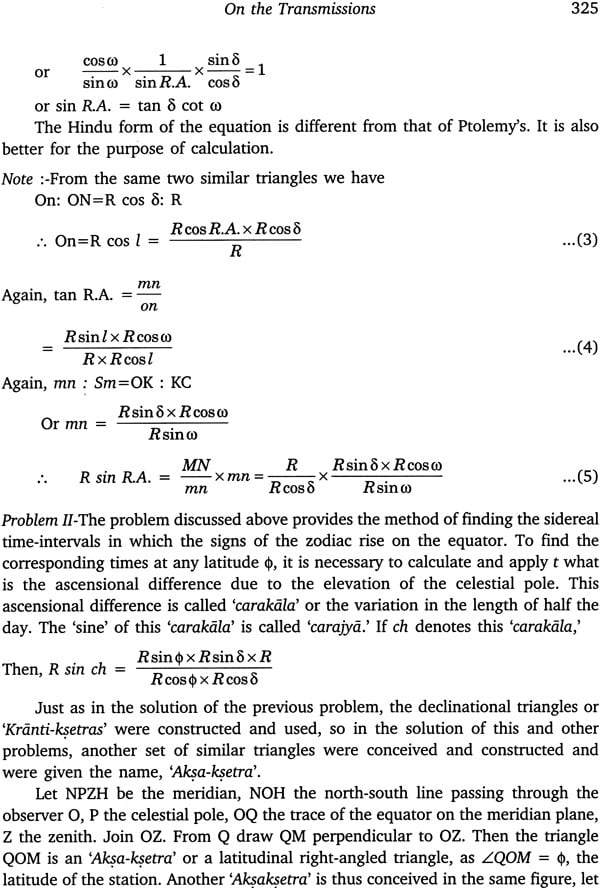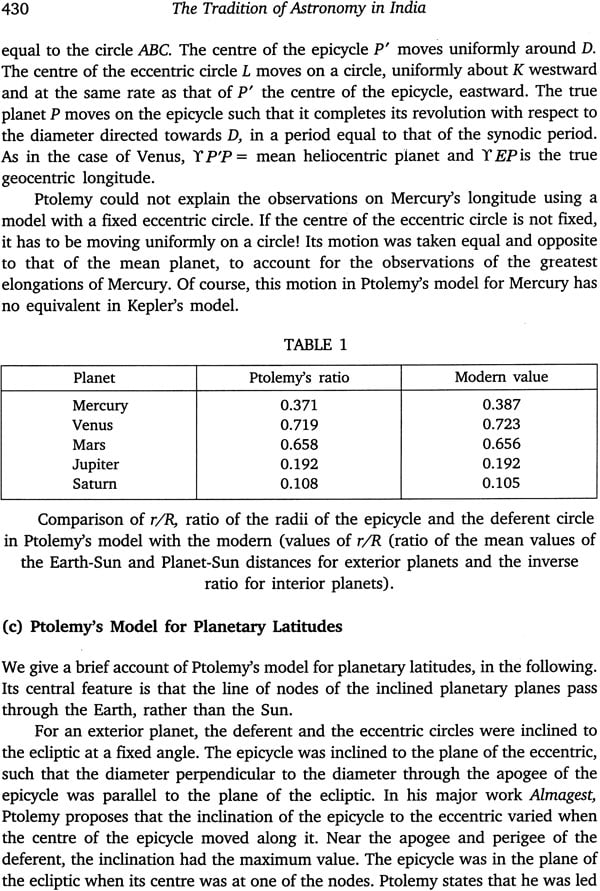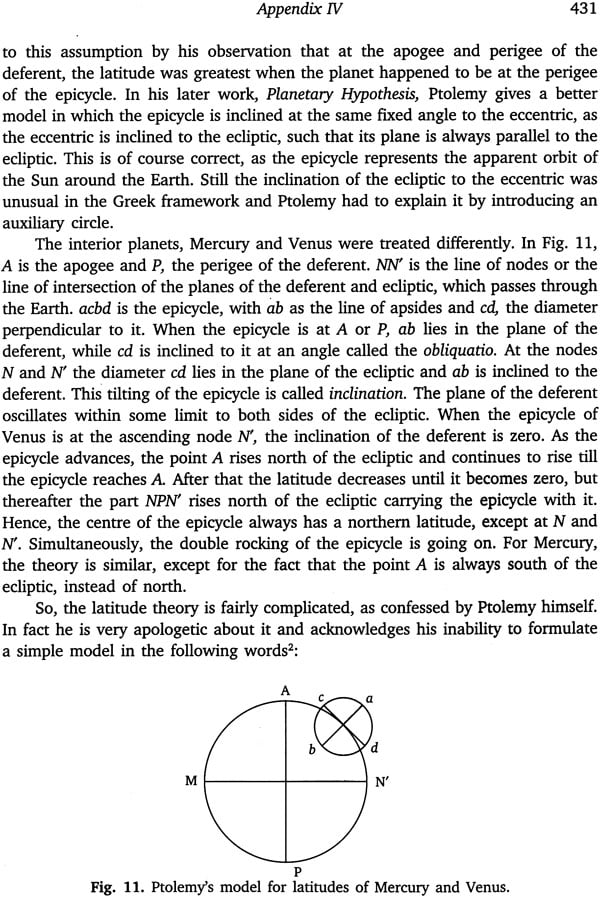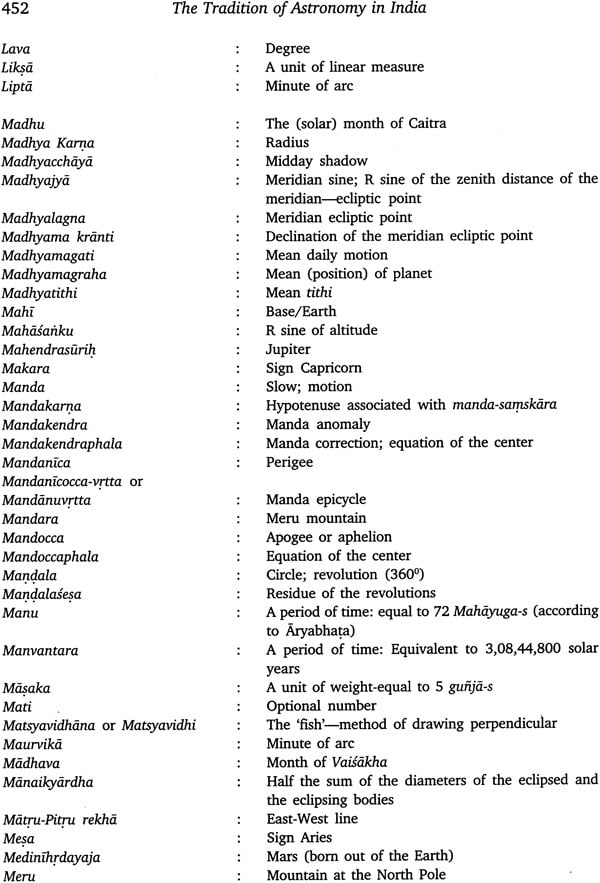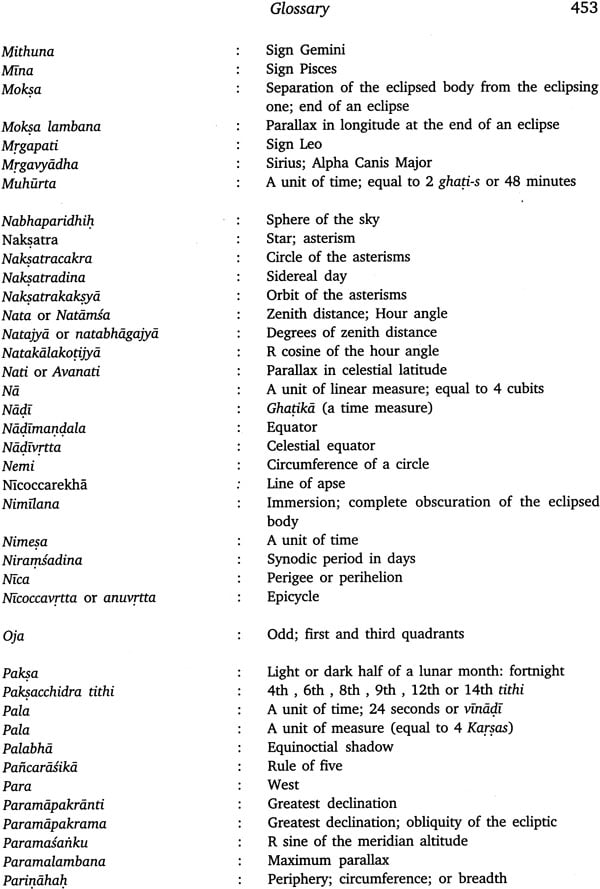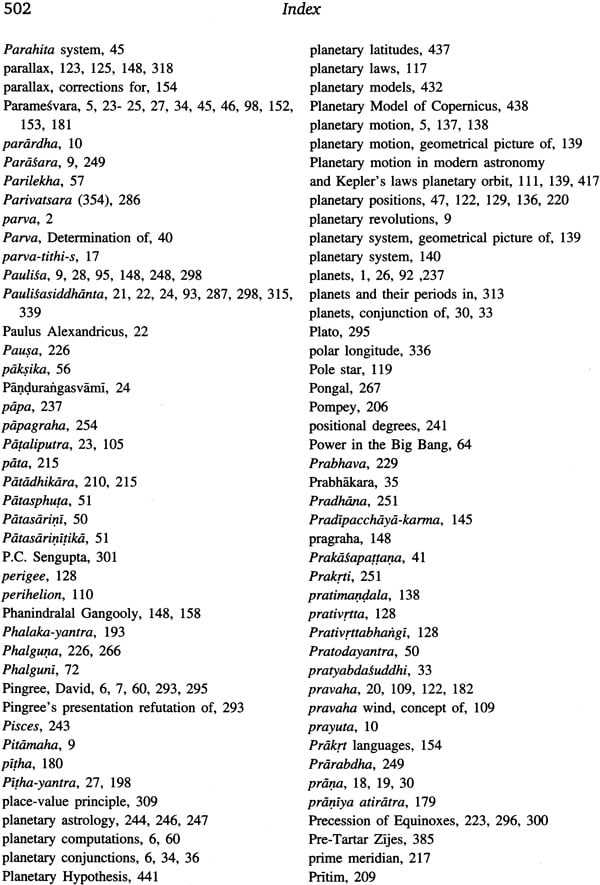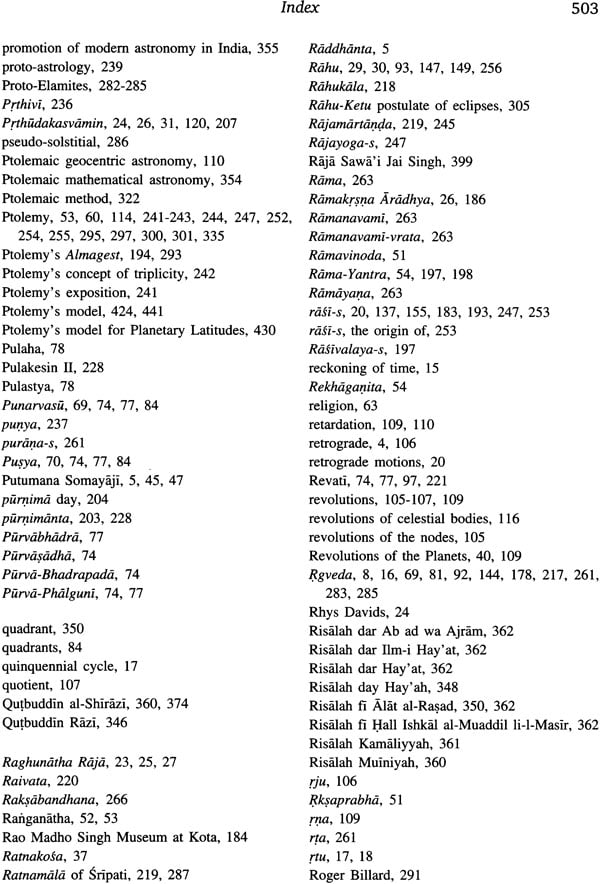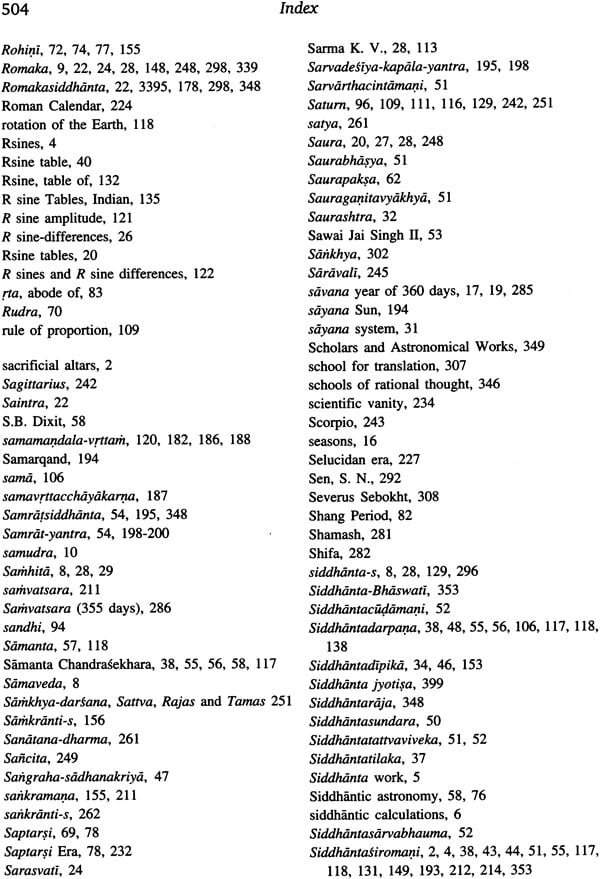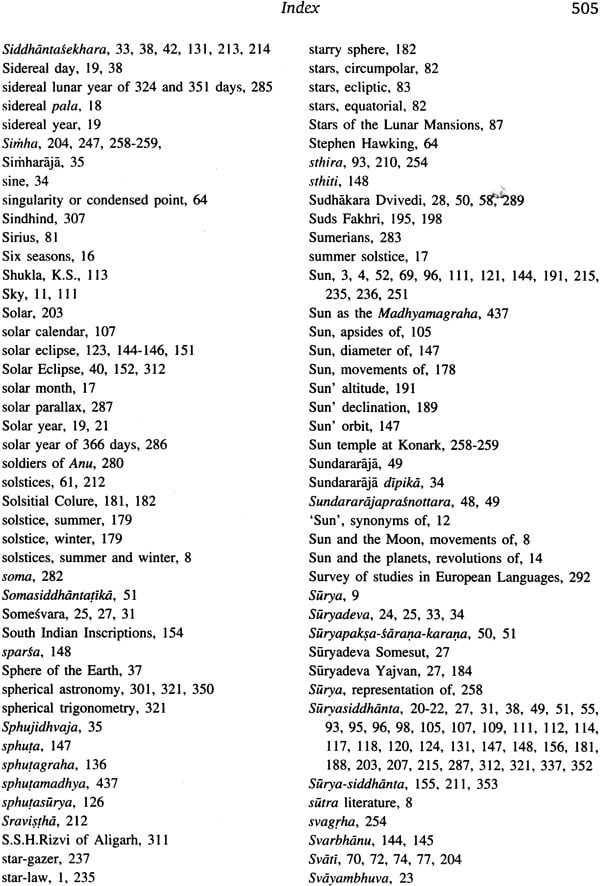
The Tradition of Astronomy in India (Jyotihsastra) (History of Science, Philosophy and Culture in India Civilization)
Book Specification
| Item Code: | NAD680 |
| Author: | B.V.Subbarayappa |
| Publisher: | Centre for Studies in Civilizations |
| Language: | English |
| Edition: | 2008 |
| ISBN: | 818758632X |
| Pages: | 544 (58 Color Illustrations) |
| Cover: | Hardcover |
| Other Details | 11.0 inch X 8.5 inch |
| Weight | 1.70 kg |
Book Description
The volumes of the Project of history of science, philosophy and culture in indian civilization aim to discover the -central aspects of India's heritage and present them in an interrelated manner. In spite of their unitary look, these volumes recognize the difference between the areas of material civilization and those of ideational culture. The Project is not being executed by a single group of thinkers, methodologically uniform or ideologically identical in their commitments. Rather, contributions are made by different scholars of diverse ideological persuasions and methodological approaches. The Project is marked by what may be called 'methodological pluralism'. In spite of its primarily historical character, this project, both in its conceptualization and execution, has been shaped by scholars drawn from different disciplines. It is the first time that an endeavour of such unique and comprehensive character has been undertaken to study critically a major world civilization.
This Volume endeavours to present the perceptible facets of the tradition of astronomy in India:- the torch-bearers of this tradition and their texts; main characteristics of Indian astronomy; scientific approach to the phenomenon of eclipse; peiiciuig« and its social dimensions including the vrata-s, festivals and other observances; origin of astrological ideas, their seeming links' with astronomy and certain contradictions; extensive computations concerning planetary revolutions in a huge cyclic period, mean as well as true positions of planets and associated mathematical aspects. In order to have the narrative undisturbed, the related mathematical astronomy has been given in the Appendices. Computations apart, Indian astronomers were keen observers of the motions of celestial bodies and used several instruments, and this aspect has been dealt with appropriately. The question of transmissions in the early centuries before and after the Christian Era vis-a-vis the originality and endogenous developments of Indian astronomy, has been addressed in an objective manner. Since Islamic astronomy has also fostered its tradition in India for over 500 years, three articles on this have been reproduced in the Appendices. Indian astronomical texts are noted for their mathematical-astronomical scientific terminology which was so standardized that it enabled astronomers (who were separated both in time and space), to articulate and promote this tradition over the centuries, as evidenced by the extensive glossary of technical terms given at the end.
It is hoped that this Volume, probably the first of its kind inasmuch as it sheds light on both the scientific and the long tradition of Indian astronomy, will be found useful by scholars and general readers alike.
D.P. CHATTOPADHYAYA studied, researched on law, philosophy and history and taught at various Universities in India, Asia, Europe and USA from 1954 to 1994. Founder-Chairman of the Indian Council of Philosophical Research (1981-1990) and President-cum-Chairman of the Indian Institute of Advanced Study, Shimla (1984-1991), Chattopadhyaya is currently the Project Director of the multidisciplinary ninety-six volume Project of History of Indian Science, Philosophy and Culture (PHISPC) and Chairman of the Centre for Studies in Civilizations (CSC). Among his thiry-five publications, of which he has authored eighteen and edited seventeen, are Individuals and Societies (1967); Individuals and Worlds (1976); Sri Aurobindo and Karl Marx (1988); Anthropology and Historiography of Science (1990); Induction, Probability and Skepticism (1991), Sociology, Ideology and Utopia (1997); Societies, Cultures and Ideologies (2000); Interdisciplinary Studies in Science, Society, Value and Civilizational Dialogue (2002) and Philosophy of Science, Phenomenology and Other Essays (2003). He has also held high public offices, namely, of Union cabinet minister and state governor. He is a Life Member' of the Russian Academy of Science and a Member of the International Institute of Philosophy, Paris.
B.V. SUBBARAYAPPA, a Visiting Professor at the National Institute of Advanced Studies, Bangalore, was formerly Executive Secretary of the Indian National Science Academy, New Delhi; first Project-Coordinator and Member-Secretary of the National Commission for History of Science in India; Professor of History of Science at Birla Institute of Science and Technology, Pilani; and Director, Discovery of India project, Nehru Centre, Bombay. His earlier publications include Chemistry and Chemical Techniques in India (ed.); Life Sciences and Medicine in India (ed.) and Indian Perspectives on the Physical World. He has also published nearly a hundred papers on history of science in India in national and international journals and other publications. He was the President (first non-Westerner to be so elected) of the Science Division of the International Union of History and Philosophy of Science, related to UNESCO (1998-2001); elected Member ofthe International Academy of History of Science, Paris (1987); recipient of Honorary Doctorate from the University of Bologna, Italy: and R.C. Gupta Endowment Prize and Medal (2003) for History of Science from the National Academy of Sciences, Allahabad.
The tradition of astronomy in India has two facets: (i) scientific; _ and (ii) its integration with the Indian religious as well as social life. Aryabhata I (fifth century AD) pioneered the former, and he was ably followed for about 1500 years by a galaxy of astronomers who were also reputed mathematicians. The texts that they have bequeathed to us are noted for their systematic presentation of the details of the mean motions and true places of the planets; nature of eclipses and parallax; the three problems of direction, place and time; planetary conjunctions; naksatra-s or asterisms; heliacal risings and settings; and astronomical instruments.
It is amazing that, though the torch-bearers of Indian astronomy lived in different times and in even far-off places at a time when communication was difficult, the topics dealt with by them as well as the chapter-headings are more or less the same, each of course endeavouring to add a veneer of excellence to the mathematical details of certain topics, and the related computations. It has been rightly stated that Indian astrono~ers excelled in computations.
The practical face of Indian astronomy has been the paficanga (tithi, vara, naksatra, yoga and katana), the tradition of which has been fostered since the Vedic times, although the yoga and karana were added later. It is hard to think of Indian astronomy and the paiiciuigc: without their association with astrology- whether it is asterisms-based Vedic astrology or the planetary one which came up around the sixth century AD. Equally hard it is to brush aside their involvement in rituals, festivals, vrata-s or special observances, marriages and other social functions marked by a commonality of approach in practically the whole of India. No wonder, then, that Indian astronomy through the medium of paiiconga-s has been fostering the fundamental unity of India in a perceptible manner.
Over the past two centuries several scholars, both foreign and Indian, have brought to light the scientific aspects of Indian astronomy. The seminal texts have been studied and some of them translated into English, and published. Nevertheless, the need for a publication encompassing both the scientific and social aspects of traditional astronomy can hardly be overemphasized.
As a first step in this direction and with the financial support of Nehru Centre, Mumbai, a publication titled: Indian Astronomy: A Source-Book, by the well known scholar, the late K.V. Sarma and myself, was brought out in 1985 at the time of the meetings-of the International Union of Astronomical Union held in New Delhi. For one reason or the other, further work could not be undertaken leading to a perspective Volume on both the scientific and social dimensions of the Indian astronomical tradition.
Four years back, Professor D.P. Chattopadhyaya Ji, the most eminent philosopher and Director of the Project of History of Indian Science, Philosophy and Culture (PHISPC) asked me to prepare a Volume on Indian astronomy under this inter-disciplinary project. I gladly accepted the assignment because this gave me an opportunity to be involved in a publication of the type envisaged earlier. I am indeed beholden to Professor D.P. Chattopadhyaya Ji for all the facilities and freedom he has given me with his characteristic generosity for the preparation of this Volume.
Since the title of the Volume is The Tradition of Astronomy in India, it occurred to me that the tradition of Islamic astronomy being fostered in India for over 700 years also needs to be included in this Volume in some form. "For fhis purpose 1 have reproduced three already published articles of two scholars (Appendices) .
I offer my special thanks to Professor Bhuvan Chandel, Member-Secretary, PHISPC for her unfailing encouragement throughout my association with PHIS PC, for over twelve years. I am deeply appreciative of: the meticulous efforts of Shri Ashoke Sen Gupta, Resident Editor, in bringing out this publication; the willing administrative help of Shri Sahdev Ram; the devoted assistance of Shri C. Gangadhara in computer-typing of the textual matter; and the diligent work of Pauls Press in the elegant printing of this book.
I
It is understandable that man, shaped by Nature, would like to know Nature. The human ways of knowing Nature are evidently diverse, theoretical and practical, scientific and technological, artistic and spiritual. This diversity has, on scrutiny, been found to be neither exhaustive nor exclusive. The complexity of physical nature, life-world and, particularly, human mind is so enormous that it is futile to follow a single method for comprehending all the aspects of the world in which we are situated.
One need not feel bewildered by the variety and complexity of the worldly phenomena. After all, both from traditional wisdom and our daily experience, we know that our own nature is not quite alien to the structure of the world. Positively speaking, the elements and forces that are out there in the world are also present in our body-mind complex, enabling us to adjust ourselves to our environment. Not only the natural conditions but also the social conditions of life have instructive similarities between them. This is not to underrate in any way the difference between the human ways of life all over the world. It is partly due to the variation in climatic conditions and partly due to the distinctness of production-related tradition, history and culture.
Three broad approaches are discernible in the works on historiography of civilization, comprising science and technology, art and architecture, social sciences and institutions. Firstly, some writers are primarily interested in discovering the general laws which govern all civilizations spread over different continents. They tend to underplay what they call the noisy local events of the external world and peculiarities of different languages, literatures and histories. Their accent is on the unity of Nature, the unity of science and the unity of mankind. The second groups of writers, unlike the generalists or transcendentalists, attach primary importance to the distinctiveness of every culture. To these writers’ human freedom and creativity are extremely important and basic in character. Social institutions and the cultural articulations of human consciousness, they argue, are bound to be expressive of the concerned people's consciousness. By implication they tend to reject concepts like archetypal consciousness, universal mind and providential history. There is a third group of writers who offer a composite picture of civilizations, drawing elements both from their local as well as common characteristics. Every culture has its local roots and peculiarities. At the same time, it is pointed out that due to demographic migration and immigration over the centuries an element of compositeness emerges almost in every culture. When due to a natural calamity or political exigencies people move from one part of the world to another, they carry with them, among other things, their language, cultural inheritance and their ways of living.
In the light of the above facts, it is not at all surprising that comparative anthropologists and philologists are intrigued by the striking similarity between different language families and the rites, rituals and myths of different peoples. Speculative philosophers of history, heavily relying on the findings of epigraphy, ethnography, archaeology and theology, try to show in very general terms that the particulars and universals of culture are 'essentially' or 'secretly' interrelated. The spiritual aspects of culture like dance and music, beliefs pertaining to life, death and duties, on analysis, are found to be mediated by the material forms of life like weather forecasting, food production, urbanization and invention of script. The transition from the oral culture to the written one was made possible because of the mastery of symbols and rules of measurement. Speech precedes grammar, poetry prosody. All these show how the 'matters' and 'forms' of life are so subtly interwoven.
II
The PHISPC publications on History of Science, Philosophy and Culture in Indian Civilization, in spite of its unitary look, do recognize the differences between the areas of material civilization and those of ideational culture. It is not a work of a single author. Nor is it being executed by a group of thinkers and writers who are methodologically uniform or ideologically identical in their commitments. In conceiving the Project we have interacted with, and been influenced by, the writings and views of many Indian and non-Indian thinkers.
The attempted unity of this Project lies in its aim and inspiration. We have in India many scholarly works written by Indians on different aspects of our civilization and culture. Right from the pre-Christian era to our own time, India has drawn the attention of various countries of Asia, Europe and Africa. Some of these writings are objective and informative and many others are based on insufficient information and hearsay, and therefore not quite reliable, but they have their own value. Quality and view-points keep on changing not only because of the adequacy and inadequacy of evidence but also, and perhaps more so, because of the bias and prejudice, religious and political conviction, of the writers.
Besides, it is to be remembered that history, like Nature, is not an open book to be read alike by all. The past is mainly enclosed and only partially disclosed. History is, therefore, partly objective or 'real' and largely a matter of construction. This is one of the reasons why some historians themselves think that it is a form of literature or art. However, it does not mean that historical construction is 'anarchic' and arbitrary. Certainly, imagination plays an important role in it.
But its character is basically dependent upon the questions which the historian raises and wants to understand or answer in terms of the ideas and actions of human beings in the past ages. In a way, history, somewhat like the natural sciences, is engaged in answering questions and in exploring relationships of cause and effect between events and developments across time. While in the natural sciences, the scientist poses questions about nature in the form of hypotheses, expecting to elicit authoritative answers to such questions, the historian studies the past, partly for the sake of understanding it for its own sake and partly also for the light which the past throws upon the present, and the possibilities which it opens up for moulding the future. But the difference between the two approaches must not be lost sight of. The scientist is primarily interested in discovering laws and framing theories, in terms of which different events and processes can be connected and anticipated. His interest in the conditions or circumstances attending the concerned events is secondary. Therefore, scientific laws turn out to be basically abstract and easily expressible in terms of mathematical language. In contrast, the historian's main interest centres round the specific events, human ideas and actions, not general laws. So, the historian, unlike the scientist, is obliged to pay primary attention to the circumstances of the events he wants to study. Consequently, history, like most other humanistic disciplines, is concrete and particularist. This is not to deny the obvious truth that historical events and processes consisting of human ideas and actions show some trend or other and weave some pattern or other. If these trends and patterns were not there at all in history, the study of history as a branch of knowledge would not have been profitable or instructive. But one must recognize that historical trends and patterns, unlike scientific laws and theories, are not general or purported to be universal in their scope.
III
The aim of this Project is to discover the main aspects of Indian culture and present them in an interrelated way. Since our culture has influenced, and has been influenced by, the neighbouring cultures of West Asia, Central Asia, East Asia and South-East Asia, attempts have been made here to trace and study these influences in their mutuality. It is well known that during the last three centuries, European presence, both political and cultural, in India has been very widespread. In many volumes of the Project considerable attention has been paid to Europe and, through Europe, to other parts of the world. For the purpose of a comprehensive cultural study of India, the existing political boundaries of the South Asia of today are more of a hindrance than help. Cultures, like languages, often transcend the bounds of changing political territories.
If the inconstant political geography is not a reliable help to the understanding of the layered structure and spread of culture, a somewhat comparable problem is encountered in the area of historical periodization. Periodization or segmenting time is a very tricky affair. When exactly one period ends and another begins is not precisely ascertainable. The periods of history designated as ancient, medieval and modem are purely conventional and merely heuristic in character. The varying scopes of history, local, national and continental or universal, somewhat like the periods of history, are unavoidably fuzzy and shifting. Amidst all these difficulties, the volume-wise details have been planned and worked out by the editors in consultation with the Project Director and the General Editor. I believe that the editors of different volumes have also profited from the reactions and suggestions of the contributors of individual chapters in planning the volumes.
Another aspect of Indian history which the volume editors and contributors of the Project have carefully dealt with is the distinction and relation between civilization and culture. The material conditions which substantially shaped Indian civilization have been discussed in detail. From agriculture and industry to metallurgy and technology, from physics and chemical practices to the life sciences and different systems of medicines-all the branches of knowledge and skill which directly affect human life-form the heart of this Project. Since the periods covered by the PHISPC are extensive-prehistory, proto-history, early history, medieval history and modem history of India-we do not claim to have gone into all the relevant material conditions of human life. We had to be selective. Therefore, one should not be surprised if one finds that only some material aspects of Indian civilization have received our pointed attention, while the rest have been dealt with in principle or only alluded to.
One of the main aims of the Project has been to spell out the first principles of the philosophy of different schools, both pro-Vedic and anti-Vedic. The basic ideas of Buddhism, Jainism and Islam have been given their due importance. The special position accorded to philosophy is to be understood partly in terms of its proclaimed unifying character and partly it is to be explained in terms of the fact that different philosophical systems represent alternative world-views, cultural perspectives, their conflict and mutual assimilation.
Most of the volume editors and at their instance the concerned contributors have followed a middle path between the extremes of narrativism and theoreticism The underlying idea has been this: If in the process of working out a comprehensive Project like this every contributor attempts to narrate all those interesting things that he has in the back of his mind, the enterprise is likely to prove unmanageable. If, on the other hand, particular details are consciously forced into a fixed mould or pre-supposed theoretical structure, the details lose their particularity and interesting character. Therefore, depending on the nature of the problem of discourse, most of the writers have tried to reconcile in their presentation, the specificity of narrativism and the generality of theoretical orientation. This is a conscious editorial decision. Because, in the absence of a theory, however, inarticulate it may be, the factual details tend to fall apart. Spiritual network or theoretical orientation makes historical details not only meaningful but also interesting and enjoyable.
Another editorial decision which deserves spelling out is the necessity or avoidability of duplication of the same theme in different volumes or even in the same volume. Certainly, this Project is not an assortment of several volumes. Nor is any volume intended to be a miscellany. This Project has been designed with a definite end in view and has a structure of its own. The character of the structure has admittedly been influenced by the variety of the themes accommodated within it. Again it must be understood that the complexity of structure is rooted in the aimed integrality of the Project itself.
IV
Long and in-depth editorial discussion has led us to several unanimous conclusions. Firstly, our Project is going to be unique, unrivalled and discursive in its attempt to integrate different forms of science, technology, philosophy and culture. Its comprehensive scope, continuous character and accent on culture distinguish it from the works of such Indian authors as P.e. Ray, B.N. Seal, Binoy Kumar Sarkar and S.N. Sen and also from such Euro-American writers as Lynn Thorndike, George Sarton and Joseph Needham. Indeed, it would be no exaggeration to suggest that it is for the first time that an endeavour of so comprehensive a Character in its awlDration of the socia1, philosophical and cultural characteristics of a distinctive world civilization-that of India-has been attempted in the domain of scholarship
Secondly, we try to show the linkages between different branches of learning as different modes of experience in an organic manner and without resorting to a kind of reductionism, materialistic or spiritualistic. The internal dialectics of organicism without reductionism allows fuzziness, discontinuity and discreteness within limits.
Thirdly, positively speaking, different modes of human experience-scientific, artistic, etc. have their own individuality, not necessarily autonomy. Since all these modes are modification and articulation of human experience, these are bound to have between them some finely graded commonness. At the same time, it has beenrecognized that reflection on different areas of experience and investigation brings to light new insights and findings. Growth of knowledge requires humans, in general, and scholars, in particular, to identify the distinctness of different branches of learning.
Fourthly, to follow simultaneously the twin principles of: (a) individuality of human experience as a whole, and (b) individuality of diverse disciplines, are not at all an easy task. Overlap of themes and duplication of the terms of discourse become unavoidable at times. For example, in the context of Dharmasastra, the writer is bound to discuss the concept of value. The same concept also figures in economic discourse and also occurs in a discussion on fine arts. The conscious editorial decision has been that, while duplication should be kept to its minimum, for the sake of intended clarity of the themes under discussion, their reiteration must not be avoided at high intellectual cost.
Fifthly, the scholars working on the Project are drawn from widely different disciplines. They have brought to our notice an important fact that has clear relevance to our work. Many of our contemporary disciplines like economics and sociology did not exist, at least not in their present form, just two centuries ago or so. For example, before the middle of nineteenth century, sociology as a distinct branch of knowledge was unknown. The term is said to have been coined first by the French philosopher Auguste Comte in 18~8. Obviously, this does not mean that the issues discussed in sociology were not there. Similarly, Adam Smith's (1723- 90) famous work The Wealth of Nations is often referred to as the first authoritative statement of the principles of (what we now call) economics. Interestingly enough, the author was equally interested in ethics and jurisprudence. It is clear from history that the nature and scope of different disciplines undergo change, at times very radically, over time. For example, in India arthaiastra does not mean the science of economics as understood today. Besides the principles of economics, it discusses at length those of governance, diplomacy and military science.
Sixthly, this brings us to the next editorial policy followed in the Project. We have tried to remain very conscious of what may be called indeterminacy or inexactness of translation. When a word or expression of one language is translated into another, some loss of meaning or exactitude seems to be unavoidable. This is true not only in the bilingual relations like Sanskrit-English and Sanskrit-Arabic, but also in those of Hindi-Tamil and Hindi-Bengali. In recognition of the importance of language-bound and context-relative character of meaning we have solicited from many learned scholars, contributions, written in vernacular languages. In order to rrnrumize the miseffect of semantic inexactitude we have solicited translational help of that type of bilingual scholars who know both English and the concerned vernacular language, Hindi, Tamil, Telugu, Bengali or Marathi. Seventhly and finally, perhaps the place of technology as a branch of knowledge in the composite universe of science and art merits some elucidation. Technology has been conceived in very many ways, e.g., as autonomous, as 'standing reserve', as liberating or enlargemental, and alienative or estrangemental force. The studies undertaken by the Project show that, in spite of its much emphasized mechanical and alienative characteristics, technology embodies a very useful mode of knowledge that is peculiar to man. The Greek root words of technology are techne (art) and logos (science). This is the basic justification of recognizing technology as closely related to both epistemology, the discipline of valid knowledge, and axiology, the discipline of freedom and values. It is in this context that we are reminded of the definition of man as homo technikos. In Sanskrit, the word closest to techne is kala which means any practical art, any mechanical or fine art. In the Indian tradition, in Saivatantra, for example, among the arts (kala.) are counted dance, drama, music, architecture, metallurgy, knowledge of dictionary, encyclopaedia and prosody. The closeness of the relation between arts and sciences, technology and other forms of knowledge are evident from these examples and was known to the ancient people. The human quest for knowledge involves the use of both head and hand. Without mind, the body is a corpse and the disembodied mind is a bare abstraction. Even for our appreciation of what is beautiful and the creation of what is valuable, we are required to exercise both our intellectual competence and physical capacity. In a manner of speaking, one might rightly affirm that our psychosomatic structure is a functional connector between what we are and what we could be, between the physical and the beyond. To suppose that there is a clear-cut distinction between the physical world and the psychosomatic one amount to denial of the possible emergence of higher logico-mathematical, musical and other capacities. The very availability of aesthetic experience and creation proves that the supposed distinction is somehow overcome by what may be called the bodily self or embodied mind.
| Dedication | VII | |
| List of Illustrations | XI | |
| Preface | XV | |
| Acknowledgements | XVII | |
| Transliteration | XIX | |
| Abbreviations | XXI | |
| General Editor and Author | XXIII | |
| General Introduction | XXV | |
| 1 | Tradition of Astronomy in India: An Overview | 1 |
| 2 | Noksatra-s | 69 |
| 3 | Planetary and Other Computations | 91 |
| 4 | Eclipses | 144 |
| 5 | Instruments | 178 |
| 6 | Paiiciinga | 203 |
| 7 | Astronomy and Astrology: An Interaction? | 235 |
| 8 | Astronomy: Vrata-s (Observances) and Festivals | 261 |
| 9 | On the Transmissions | 279 |
| Appendices: | 343 | |
| On the Transmission of Islamic Astronomy to Medieval India | 345 | |
| Ghulam Husain Jaunpiiri and his Zij-i Bahadurkhani | 374 | |
| Development of Zij Literature in India | 383 | |
| Planetary Models in Indian and Greek Astronomical Traditions | 416 | |
| Glossary | 444 | |
| Bibliography | 459 | |
| Index | 489 |
